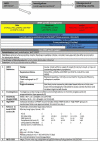Guidelines on the management of acute respiratory distress syndrome
- PMID: 31258917
- PMCID: PMC6561387
- DOI: 10.1136/bmjresp-2019-000420
Guidelines on the management of acute respiratory distress syndrome
Abstract
The Faculty of Intensive Care Medicine and Intensive Care Society Guideline Development Group have used GRADE methodology to make the following recommendations for the management of adult patients with acute respiratory distress syndrome (ARDS). The British Thoracic Society supports the recommendations in this guideline. Where mechanical ventilation is required, the use of low tidal volumes (<6 ml/kg ideal body weight) and airway pressures (plateau pressure <30 cmH2O) was recommended. For patients with moderate/severe ARDS (PF ratio<20 kPa), prone positioning was recommended for at least 12 hours per day. By contrast, high frequency oscillation was not recommended and it was suggested that inhaled nitric oxide is not used. The use of a conservative fluid management strategy was suggested for all patients, whereas mechanical ventilation with high positive end-expiratory pressure and the use of the neuromuscular blocking agent cisatracurium for 48 hours was suggested for patients with ARDS with ratio of arterial oxygen partial pressure to fractional inspired oxygen (PF) ratios less than or equal to 27 and 20 kPa, respectively. Extracorporeal membrane oxygenation was suggested as an adjunct to protective mechanical ventilation for patients with very severe ARDS. In the absence of adequate evidence, research recommendations were made for the use of corticosteroids and extracorporeal carbon dioxide removal.
Keywords: ARDS.
Conflict of interest statement
Competing interests: Each author contributed elements to the final text.
Figures



References
-
- O'Gara B, Fan E, Talmor DS. Controversies in the management of severe ARDS: optimal ventilator management and use of rescue therapies. Semin Respir Crit Care Med 2015;36:823–34. - PubMed
-
- Fan E, Del Sorbo L, Goligher EC, et al. . An official American thoracic Society/European Society of intensive care Medicine/Society of critical care medicine clinical practice guideline: mechanical ventilation in adult patients with acute respiratory distress syndrome. Am J Respir Crit Care Med 2017;195:1253–63. 10.1164/rccm.201703-0548ST - DOI - PubMed
Publication types
MeSH terms
Substances
Grants and funding
LinkOut - more resources
Full Text Sources
Other Literature Sources
Medical
